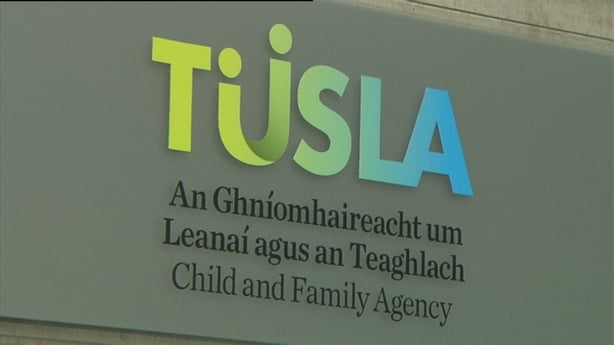An inspection of a child protection and welfare service by the Health Information and Quality Authority (HIQA) found that children who alleged abuse, inappropriate contact and sexual assault were left on waiting lists for months.
The HIQA inspection of Tusla's child protection and welfare service in April found that the Child and Family Agency failed to take steps to identify children who were not receiving care and protection.
HIQA found "a chronic shortfall" in staffing resources to meet demand, including gaps in the monitoring and oversight of waitlist cases and completion of safety planning.
Many children and families in the Dublin south, west Kildare and west Wicklow service area were waiting prolonged periods for preliminary inquiries and initial assessments to take place.
The report outlines what inspectors found when they reviewed files during the inspection.
They included the case of a four-year-old who had alleged inappropriate contact by an older child. They remained on the waiting list five months later.
Given the age of the child, HIQA has said their ability to recount the incident months later may not be reliable.
In another case, a teenager who alleged sexual assault 14 months prior to the inspection, was still on a waiting list.
Another teenager who also alleged sexual assault eight months before HIQA examined the file, remained on the waitlist with no direction to support services outlined.
Children under the age of eight were referred because they were found home alone. The case was on a waiting list for four months. While attempts were made to contact the family, these were not successful.
This case was brought to the attention of staff during the inspection. However, they were unable to determine if the children were still residing at the address provided.
The HIQA inspectors concluded that the children, therefore, may have moved to another area and the risks to them remained unassessed and unaddressed.
Minister for Children Roderic O'Gorman described the report as concerning and said there is a very significant problem recruiting and retaining social workers.
However, he added that most children in most urgent need were seen in the correct timeframe.
Speaking on RTÉ's Today with Philip Boucher-Hayes, Mr O'Gorman said that efforts to hire more social workers are under way, including recruitment through the graduate entry programme and allowing Tusla to recruit abroad.
Mr O'Gorman said 90% of children in care in Ireland are in foster care, which is higher than most EU countries and added that efforts to enhance foster care allowances in this years budget are being examined.
The region

The report offers a profile of the region and has noted it as "a diverse area" with four county boundaries: Co Kildare, Wicklow, south Dublin and Dublin south city.
The area comprises a mix of rural communities (such as Balltinglass, Co Wicklow), large rural towns (such as Naas, Co Kildare), commuter belt towns (for example Leixlip, Co Kildare) and Dublin south city areas (such as Crumlin and Tallaght).
It is the second largest of the 17 Tusla areas, with 27% of the population under 18 years inclusive, totalling 108,186 children and young people.
There were 11,788 people residing in areas classed as the most disadvantaged in 2016, which was 10.8% of the area's population.
Of this group, 29.2% or 3,446 were under the age of 18.
At the time of the inspection the area was carrying a large number of vacancies across child protection and welfare, intake and assessment, children in care, fostering, aftercare and business support teams.
Background to the inspection

The area has been a service area of concern to HIQA since 2019, when an inspection found it to be non-compliant with all four standards inspected against.
Further inspections over the following years saw improvements, however, despite assurances being sought by HIQA, the watchdog remained dissatisfied.
In February 2023, the Chief Inspector of HIQA wrote to the Assistant Secretary General of the Department of Children, Equality, Disability, Integration and Youth to outline the risks identified in relation to the child protection and welfare service in Dublin south, west Kildare and west Wicklow.
A decision was taken to conduct a risk-based inspection of the child protection and welfare service to confirm that the assurances were being actioned and were keeping children, waiting for a social worker to be assigned, safe.
In March 2023, a service improvement plan was received from Tusla.
The inspection
The HIQA inspection focused on the management of child protection and welfare referrals waiting for a preliminary inquiry and or an initial assessment to be carried out.
As well as a chronic staff shortage, many children and families were waiting prolonged periods for preliminary inquiries and initial assessments to take place.
There were clearly defined governance arrangements and lines of accountability in the area and management was attempting to mitigate the risks in the area.
However, they faced many competing demands and were required to prioritise risks within their existing resources.
As a result, HIQA found that the area management was unable to direct adequate resources for the care and protection of all children.

Overall, the quality and safety of the child protection and welfare service required "significant improvement" to ensure it met the needs of all children and their families who required the service.
There was an "unacceptably long wait time" for preliminary inquiries to take place, especially for cases prioritised as low or medium-risk at screening.
Preliminary inquiries provide further information to determine what action is required to address the needs of and risks to the child.
As inquiries did not take place in a timely fashion, the risk to these children was largely unknown, according to HIQA.
This meant that children and families were not receiving the right service at the right time and many children remained on waitlists for extended periods without being provided with the relevant supports.
On a positive note, the report has noted referrals identifying immediate or high-risk to children were responded to quickly and there were no high priority cases awaiting allocation.
Files reviewed

Out of the 49 cases reviewed, the area's standard operating procedure should have been applied to 42 of them.
The standard operating procedure stated that all referrals awaiting allocation, categorised as abuse, should be reviewed monthly by a manager, while all welfare referrals should be reviewed quarterly.
However, there were only 16 cases with reviews on file. Of those, seven were carried out the week before or while HIQA was conducting its inspection.
This meant that 72% of the cases, where the standard operating procedure applied, had no oversight by management.
There was often a lack of analysis and decisive action being taken when reviews were being carried out.
This led to little or no change for the children whose files were reviewed, according to HIQA, and did not shorten waiting time.
In one example, a child who waited 14 months for the completion of an initial assessment from the time of referral was reviewed by managers three times in that period.
Two of the three reviews stated, "remain on waiting list", while the other had no clear actions.
While the child was safe, they had experienced trauma that led to the referral.
At the point of the HIQA inspection, the report has said it was questionable whether an assessment so long (14 months) after the event would be re-traumatising for the child.
They had not received the right service at the right time according to the report.
"This child remaining on a waiting list for so long, meant that it was possible if not likely they would age out (turn 18) before receiving a service," it said.
Inspectors found a similar concern in the case of a preschool-aged child.
"Too much time may have passed for the child to possibly remember the detail of the traumatic event, and again this child went without a service," the report said.
Despite this, HIQA has noted that the review by managers, in both cases, indicated they should remain on the waiting list, instead of being offered an alternative service and closed.
There were a further four cases reviewed by inspectors similar to these examples.
National picture

The inspection found that monitoring and oversight of the service area at a national level required improvement.
HIQA has noted that the Tusla national office monitors activity using national metrics, however the inspectors questioned "the effectiveness of this monitoring in improving a service" and said the accuracy of figures was questionable.
Unallocated cases rose from 29% of open cases at the end of quarter one 2022 to 43% of open cases at the end of quarter three 2022.
In quarter two and three of 2022, the area had the highest number of unallocated cases of all 17 Tusla areas.
Consistently, it also had either the highest or second highest referral rate in the country during that period.
"These figures clearly demonstrate the pressure the area was under and the demands on their service. This did not, however, appear to result in changes in terms of internal monitoring from Tusla’s national office," according to the report.
The Health Information and Quality Authority found the service to be non-compliant with all three standards under which it was assessed.
Tusla outlined ways in which it would come into compliance with HIQA standards including additional capacity to allow for greater oversight, monitoring and governance across the intake and assessment teams in the area.
It also said it would hire more social workers and that an intermediate response has been devised to reduce all referrals awaiting preliminary inquiries across the area.






